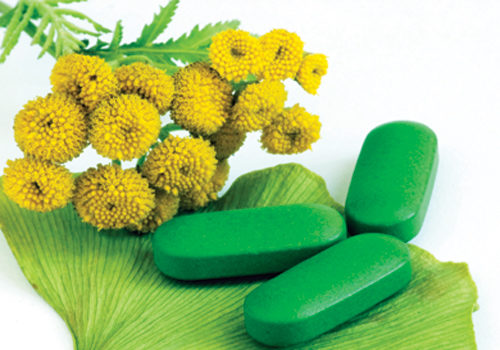Vitamin C. Echinacea. Zinc. These supplements are some of the hottest tickets on the Immune Health Express. What was once perhaps rightfully regarded as a seasonal buy has recently shot into the fast lane of year-round hot sellers for several reasons that we’ll discuss down the road.
“Immunity is one of the fastest growing segments in the natural products industry,” says Jay Levy, director of sales at Wakunaga of America Co., Ltd., Mission Viejo, CA.
Levy says that the Natural Marketing Institute’s 2013 Healthy Aging Database shows one-half of U.S. adults claim to be concerned about supporting their immune health at some point in life, with a significant spike in concern among those in their 30s. It is a category with broad and consistent appeal, and being knowledgeable about it will put you in good stead with customers of all ages.
So, hop aboard as we take a tour of the supplements and the studies that many category leaders are focusing on now.
Top Supplements and New Research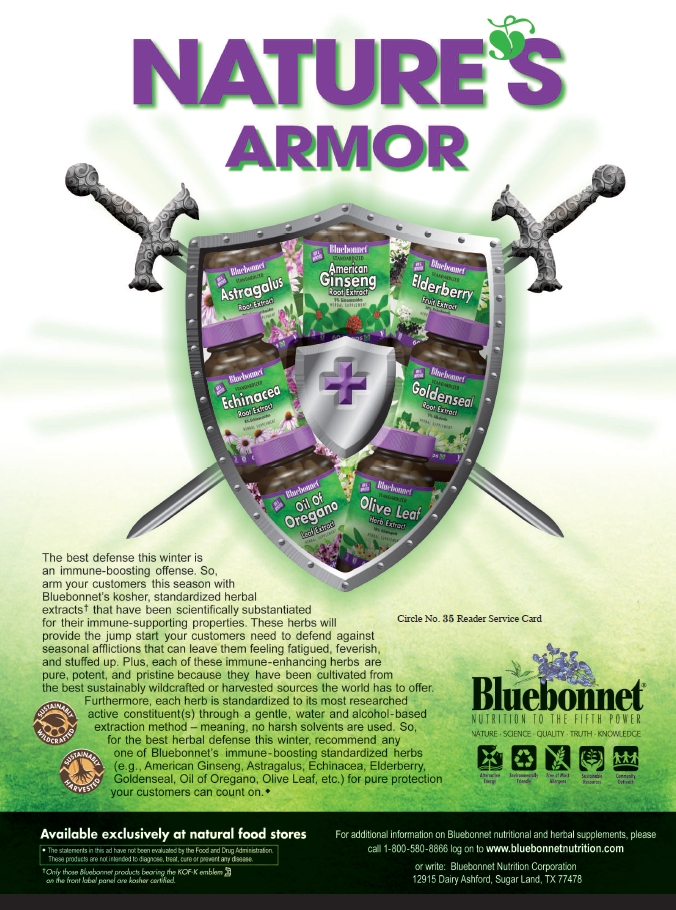
Well-known category leaders have some extra company with up-and-coming immune health supplements. “While the focus continues to be on foods and supplements that are high in antioxidants, other nutrients such as herbs, probiotics and phytosterols are gaining awareness among consumers for their immune supportive properties,” Levy says.
Probiotics. Though consumers still usually associate them with digestive benefits, the growth of probiotics and prebiotics in the immune health space is a major trend to note. Dan Lifton, CEO of Quality of Life Labs, Purchase, NY, says their overall popularity has gotten a boost from the high-profile promotion of yogurt products by key consumer packaged goods players.
A large shift has taken place very recently with the realization that pro- and prebiotics can impact immune health in other areas besides the gastrointestinal tract, according to Dallas Clouatre, Ph.D., consultant for R&D to Jarrow Formulas, Inc., Los Angeles, CA.
Probiotics can strengthen the barrier function of intestinal walls and stimulate the body’s production of natural killer (NK) cells and T cells, Levy says. One study into the effects of probiotic strains on Clostridium dificile found specific immunomodulatory benefits (1).
Some additional applications for probiotics in the immune health category will be discussed later.
Antioxidants. Often associated with heart health, aged garlic extract (AGE) contains compounds like S-allyl cysteine that provide antioxidant benefits for immune health. Later, we’ll hear about research that found it could help reduce the duration of colds.
Oregano oil has antioxidant and antibacterial properties, thanks to a phenol it contains called carvacrol. “Studies suggest that the oxygen molecules in carvacrol team up with the water in the body to create heat that kills bacteria,” says Levy. Researchers recently found that oregano, in combination with sage, modulated innate immunity in an animal model by benefiting nitric oxide status and phagocytic activity (2).
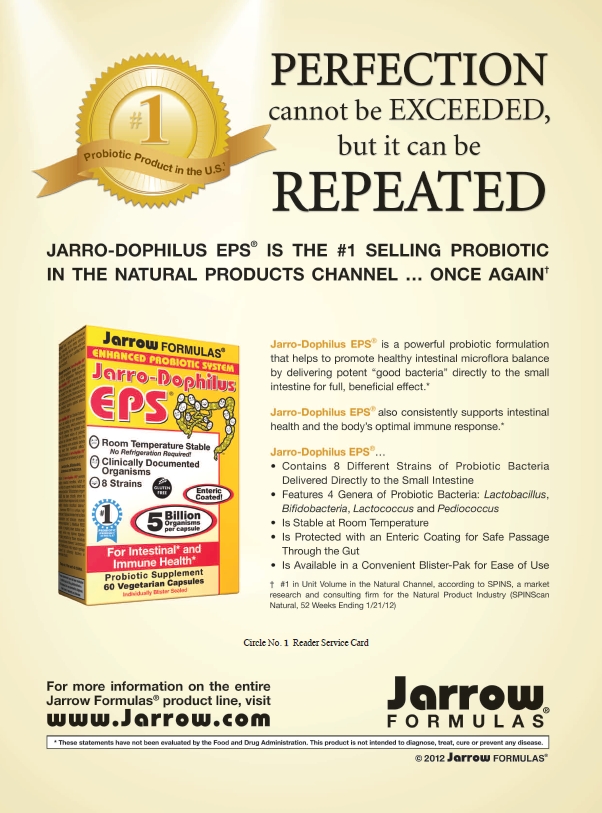 Like vitamin C (which we will discuss more in the context of recovery), zinc is essential for building immunity, and offers direct antiviral activity, says Michele McRae, C.N., senior director of research, formulation and quality for Rainbow Light Nutritional Systems, Inc., Santa Cruz, CA.
Like vitamin C (which we will discuss more in the context of recovery), zinc is essential for building immunity, and offers direct antiviral activity, says Michele McRae, C.N., senior director of research, formulation and quality for Rainbow Light Nutritional Systems, Inc., Santa Cruz, CA.
In fact, zinc plays a part in many immune system reactions. “It promotes the destruction of foreign particles and microorganisms, acts as a protectant against free-radical damage, acts synergistically with vitamin A, is required for proper white blood cell function and proper T cell levels, and is a necessary cofactor in activating serum thymic factor,” says McRae. Thymic factor is a hormone that has “profound immune-enhancing properties,” she says.
Over 300 enzymes in the body are zinc-dependent, adds Susan Hazels Mitmesser, Ph.D., director of nutrition research for American Health/Ester-C, Ronkonkoma, NY. Zinc helps stabilize the structure of certain proteins, and zinc deficiency can increase the vulnerability of cell membranes to oxidative stress, she explains.
Beyond zinc, other minerals and trace minerals like selenium are supportive of the immune system, according to Chris D. Meletis, N.D., director of science and research for Trace Minerals Research, Ogden, UT. Vitamin D also exerts massive influence, he says, offering support to autoimmune responses and cellular integrity. “It is no surprise that vitamin D levels drop at the same time that colds and flus increase each and every year,” Meletis says.
Indeed, “there has been strong growth in the vitamin D category due to emerging research on the link between vitamin D deficiency and weakened immunity,” says Lifton.
For much more on vitamin D, we turn to Trisha Sugarek MacDonald, B.S., M.S., director of R&D/national educator for Bluebonnet Nutrition Corp., Sugar Land, TX. The physiologically active form of vitamin D, calcitriol, functions as a hormone in the body by binding with vitamin D receptors. It has been recognized for significant and widespread immune effects throughout the body, she says, affecting both arms of the immune system. According to Sugarek MacDonald, vitamin D’s myriad effects as a potent immunomodulator include increased production of peptides that may inactivate viruses; increased production of antimicrobial peptides such as defensin; enhancement of regulatory T cells; decreased inflammation through cytokine modulation and countless others.
The regulation of inflammation is of central 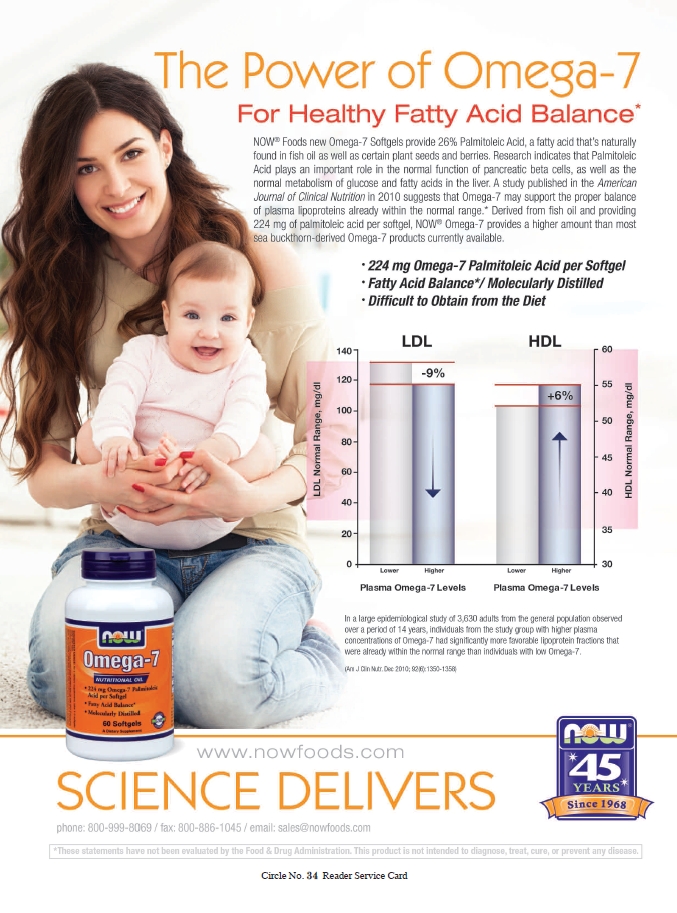 importance to immune health, and supplementing with antioxidant compounds can be an effective way of addressing the issue. Alpha-lipoic acid is one such compound, and according to Clouatre, most supplements include equal amounts of the (R) and (S) forms of this antioxidant. He adds, however, that the (R) form, also called RALA, is the only one made naturally by the body. “RALA promotes the synthesis of glutathione and the induction of Phase II detoxification enzymes,” both integral to immune responses, Clouatre says.
importance to immune health, and supplementing with antioxidant compounds can be an effective way of addressing the issue. Alpha-lipoic acid is one such compound, and according to Clouatre, most supplements include equal amounts of the (R) and (S) forms of this antioxidant. He adds, however, that the (R) form, also called RALA, is the only one made naturally by the body. “RALA promotes the synthesis of glutathione and the induction of Phase II detoxification enzymes,” both integral to immune responses, Clouatre says.
The carotenoid class of compounds can also deliver antioxidant benefits. Bryan See, regional product manager for Carotech Inc., Edison, NJ, adds that, “Some carotenoids such as beta-carotene and alpha-carotene act as precursors of vitamin A.” He points out that the benefits of vitamin A for immune support are well established. It has an approved health claim from the European Food Safety Authority (EFSA), allowing the use of phrases such as “Vitamin A helps the proper functioning of the immune system” on product labels.
See notes, however, that carotenoid supplements may be preferable to vitamin A because high vitamin A intake can lead to toxicity. Pro-vitamin A carotenoids will only undergo the cleavage process to become vitamin A as needed.
Vitamin E is another potent antioxidant you should be familiar with. “Tocotrienol, a form of vitamin E, has also been found to significantly improve immune response,” See says. Tocotrienol exists in four forms: alpha, beta, gamma and delta. Recent research into proprietary tocotrienol complexes (Tocomin and Tocomin SupraBio from Carotech) provides a window into their potential immune benefits.
In an animal study, researchers fed old and young mice the proprietary tocotrienol, and found significant improvement in age-related decline in T cell function. The supplement regimen also reduced C-reactive protein, an inflammatory marker, in the liver of both groups of mice (5).
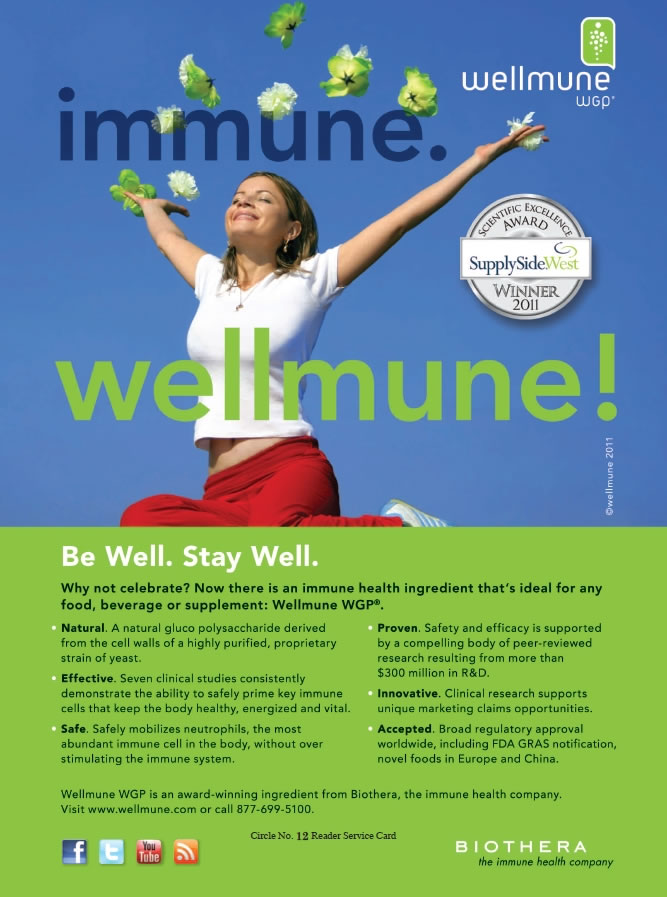 Hazels Mitmesser highlights the role of a familiar set of nutrients for immunity. “Several lines of research indicate a role for omega-3 fatty acids in the modulation of the immune system, but human intervention trials measuring clinical outcomes are still evolving,” she says. Omega-3s are needed to form part of the membranes of immune cells, she explains, and it has been discovered that increased omega-3 intake is linked with higher EPA concentrations in immune cell membranes.
Hazels Mitmesser highlights the role of a familiar set of nutrients for immunity. “Several lines of research indicate a role for omega-3 fatty acids in the modulation of the immune system, but human intervention trials measuring clinical outcomes are still evolving,” she says. Omega-3s are needed to form part of the membranes of immune cells, she explains, and it has been discovered that increased omega-3 intake is linked with higher EPA concentrations in immune cell membranes.
Vaccines support. Another study that See cites, a randomized, double-blind, placebo-controlled human trial, discovered that the tocotrienol complex just mentioned improved immune responses to a tetanus vaccination. Some 108 young women were divided into a control and an experimental group, and those who took the supplement rather than a placebo saw increased interferon-g and interleukin (IL)-4 levels, leading researchers to conclude that tocotrienol could improve responses to immunizations (6).
An immune ingredient derived from arabinogalactan (ResistAid from Lonza) was used to increase the antibody response in healthy volunteers receiving a pneumonia vaccine, according to Bryan Rodriguez, commercial development manager for Lonza, Allendale, NJ (14). “Vaccination studies of this type are used to study general immune function, with the vaccination being the immune system stressor,” he says.
Designed to deliver “triple action” immune support, Rodriguez says that this ingredient can help increase beneficial immune cell populations. It has been found to help modulate the two arms of the immune system (innate and adaptive) from the gastrointestinal tract, so that the whole system can respond appropriately when challenged by foreign substances. Finally, its flavonoid content delivers antioxidant support, as well.
Rodriguez touts the ability to support appropriate immune responses, as opposed to indiscriminately up-regulating or stimulating the immune system. “A stimulatory approach simply forces the entire immune system into action. Continual stimulation may lead to reduced capability of the immune system as resources are called upon to react and may be depleted,” he says.
A wide selection of mushrooms has traditionally been used to 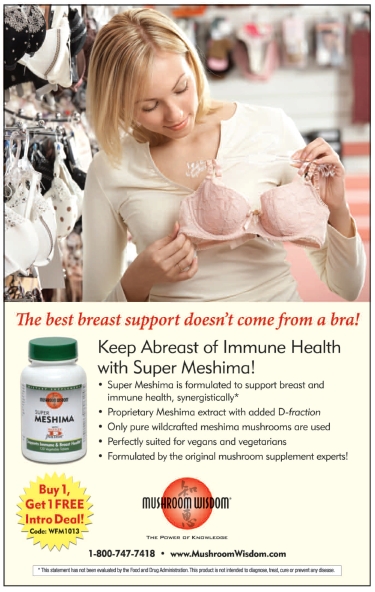 support immunity, says Mark Kaylor, vice president of education and research for Mushroom Wisdom Inc., East Rutherford, NJ. These include shiitake, reishi and cordyceps. More recent focus, however, has been placed on maitake mushroom for its ability to activate healthy immune responses. Kaylor says that when scientists compared maitake with other traditional mushrooms, it was found to be the most effective in supporting immunity, especially a specific component of maitake called D-Fraction.
support immunity, says Mark Kaylor, vice president of education and research for Mushroom Wisdom Inc., East Rutherford, NJ. These include shiitake, reishi and cordyceps. More recent focus, however, has been placed on maitake mushroom for its ability to activate healthy immune responses. Kaylor says that when scientists compared maitake with other traditional mushrooms, it was found to be the most effective in supporting immunity, especially a specific component of maitake called D-Fraction.
Lifton also notes growth in demand for mushroom-based products. He says new research on a patented, fermented extract of Japanese medicinal mushrooms (AHCC) showed it could enhance the efficacy of flu shots. Higher antibody titers against influenza B virus were found in those who had supplemented than in those who had received the flu shot alone (8). Other research has examined the ingredient’s potential in cases of HPV.
Cold and flu research. Before detailing the way a few more antioxidant compounds can help with the common cold, Sugarek MacDonald gives us a small primer on the subject. Characterized by a group of symptoms presenting in the upper respiratory tract, the common cold is caused by several different viruses, the most notorious being rhinovirus, she says. The cold virus enters and attaches to the lining of the nose and/or throat, stimulating a white blood cell (WBC) response.
Unless you’ve dealt with that exact strain before, the first line of defense fails, and the body sends in more immune troops. The nose and throat become inflamed and produce excess mucus. Energy is sapped, and congestion, sore throat and sneezing ensue. Both cold and flu cause coughing, headache and chest discomfort, but the flu also typically brings a fever and other symptoms like weakness, Sugarek MacDonald says.
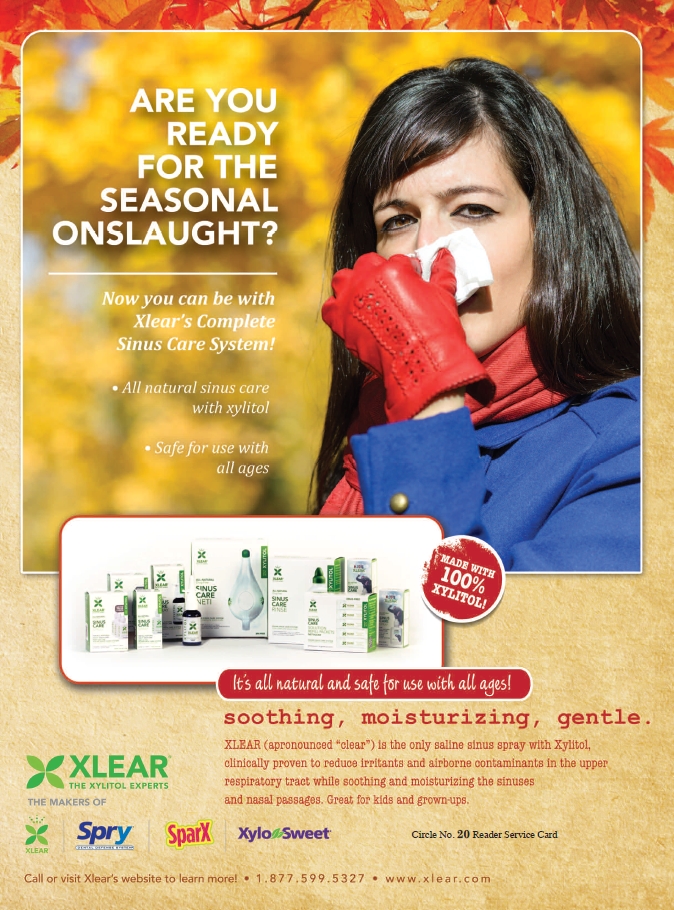 More than 100 cold viruses are known, and new flu strains evolve every few years. Antibiotics won’t help with either of these types of viral invaders. To make matters worse, no medications specifically treat the common cold, and relatively few antiviral medications can be obtained to treat flu cases. For Sugarek MacDonald, this all means that the burden of reducing the incidence and severity of these conditions falls in part to supplements. “Certain natural agents like elderberry, resveratrol and quercetin have the ability to interfere with the way cold and flu viruses affect and alter healthy DNA in your cells,” she says.
More than 100 cold viruses are known, and new flu strains evolve every few years. Antibiotics won’t help with either of these types of viral invaders. To make matters worse, no medications specifically treat the common cold, and relatively few antiviral medications can be obtained to treat flu cases. For Sugarek MacDonald, this all means that the burden of reducing the incidence and severity of these conditions falls in part to supplements. “Certain natural agents like elderberry, resveratrol and quercetin have the ability to interfere with the way cold and flu viruses affect and alter healthy DNA in your cells,” she says.
In general, such supplements can help to block the replication of the virus inside the body, and work with the immune system to help kill and suppress virus cells. Elderberry fruit extract provides flavonoids, which are potent antioxidants. By donating electrons to free radicals, antioxidants like flavonoids can neutralize them, thereby preventing oxidative damage to cells. A recent in vivo trial found that the antioxidant activity of elderberry contributed to its anti-influenza A virus activity, according to Sugarek MacDonald. Levels of immunoglobulin A (IgA), an antibody critical to mucosal immunity, were increased (7).
Resveratrol is a natural antibiotic produced within plants as a response to injury. “Resveratrol protects the plant against UV radiation, fungal attacks and/or infection and can be beneficial for humans in the same manner,” says Sugarek MacDonald, noting past studies have documented the way resveratrol benefits flu cases by inhibiting replication and reducing airway inflammation.
The flavonoid quercetin is a natural anti-viral compound, in part due to its ability to inhibit reverse transcripterase, needed for the replication process of retroviruses. Oral quercetin supplementation has been found to increase lung concentrations of various antioxidants like catalase and superoxide dismutase, she says. This allows for protection against the oxygen-derived free radicals released during an influenza infection.
Medicinal mushrooms, meanwhile, are also  believed to stimulate immunity at the cellular level, according to Christopher Hobbs, Ph.D., L.Ac., director of herbal science for Rainbow Light. The National Institute of Health provides funding for the study of medicinal mushrooms, he says, adding that he believes consumers are becoming more aware of their immune benefits.
believed to stimulate immunity at the cellular level, according to Christopher Hobbs, Ph.D., L.Ac., director of herbal science for Rainbow Light. The National Institute of Health provides funding for the study of medicinal mushrooms, he says, adding that he believes consumers are becoming more aware of their immune benefits.
Lifton notes that proprietary forms of other established supplements like vitamin C and herbs like andrographis have been developed for the immune support market. “Andrographis is a bitter herb that comes from tropical countries, and is extremely popular throughout southeast Asia, China and India for treating fevers and viral infections,” says Hobbs. He calls andrographis and elderberry perhaps the most scientifically studied herbs for flu support. One study he points to found that a group taking acetaminophen along with andrographis had fewer symptoms, including cough and fatigue, than a group taking acetaminophen only (9).
Hobbs also advises that berberine sulfate has been shown to have broad-spectrum antibiotic activity, and is therefore helpful in preventing secondary bacterial infections due to viral infections of the upper respiratory tract.
According to Eileen Sheets, managing director of Bioforce USA, Ghent, NY, experts feel that a combination of anti-inflammatory and anti-viral effects is the best approach to intervening in the common cold. Recent research into echinacea found that its anti-viral activity is concentrated in the aboveground herb and flower heads, and not in the roots (3).
In contrast, “previous studies have demonstrated the anti-inflammatory potential of alkylamides that are found primarily in the roots of echinacea,” Sheets says. These alkylamides have been found to bind to CC-2 receptors and mediate the inflammatory response. One study found that just 5% of the root can modulate the inflammatory marker TNF-a as much as 95% of the herb (4). Sheets notes that this ratio is reproduced in a proprietary echinacea (Echinaceaforce from Bioforce USA), providing the synergy of anti-viral and anti-inflammatory effects.
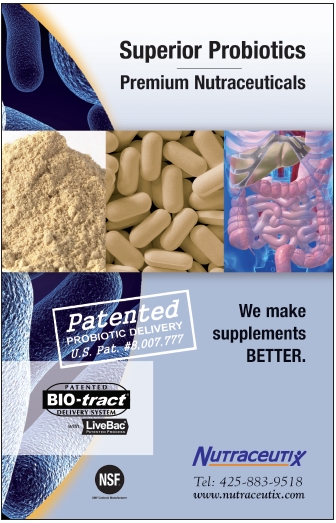 Meanwhile, Clouatre says recent findings at the 2nd World Congress on Immunity Ingredients found specific probiotic strains can influence immune responses to such challenges as colds, flu and other common infections.
Meanwhile, Clouatre says recent findings at the 2nd World Congress on Immunity Ingredients found specific probiotic strains can influence immune responses to such challenges as colds, flu and other common infections.
Prebiotics (which serve as food for probiotics) have been shown to cut down on colds and flu by as much as 40% in certain contexts (10). “Interestingly, some ingredients that are usually presented almost exclusively as immune boosters also are prebiotics that encourage the growth of desirable intestinal bacteria,” Clouatre says. A study Clouatre cites found that one prebiotic ingredient (Epicor from Embria Health Sciences) can lead to gradual beneficial changes in the gut probiotic community and a reduction in potential pathogens (11).
He adds that the most active area of research in this segment is synbiotics, or combinations of pre- and probiotics. “Synbiotic fermentations have demonstrated wide-ranging forms of protection, including not only immune activation, but also anti-inflammatory effects and reduced chemo-activation,” Clouatre says.
Oral health. Nena Dockery, technical support manager for Stratum Nutrition, a Novus Intl business, St. Charles, MO, points us to probiotics from a different angle. “One area that we are just beginning to recognize for its critical role in immune system health and overall wellness is oral health. Many good substances, as well as bad, enter our body through the oral cavity,” she says. A probiotic ingredient designed to benefit the mouth and throat (BLIS K12) can help protect a healthy immune system, starting in the mouth, she explains.
A strain of Streptococcus salivarius, the probiotic secretes bacteriocin-like-inhibitory-substances (BLIS) that help maintain a healthy oral cavity. Most initial studies in this area focused on finding the right BLIS-secreting strains, but Dockery says that recent research has focused on supplementation and results. Two recent studies from Italy found reduced incidence of common ear, nose and throat ailments in children, and similar benefits for upper respiratory immune support in adults (12) (13).
Post-exercise immune support. Richard G. 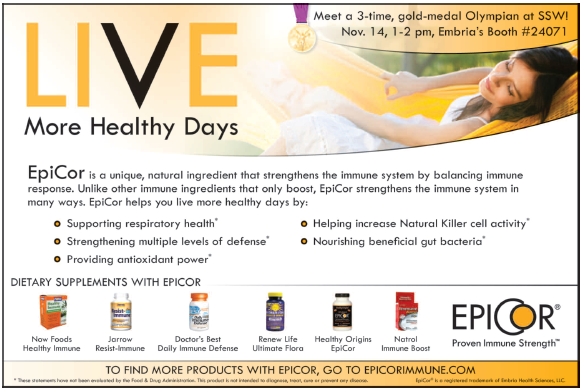 Mueller, CEO of Biothera, Eagan, MN, refers us to a beta 1,3/1,6 glucan ingredient (Wellmune from Biothera) that is derived from a proprietary strain of baker’s yeast. The Journal of Dietary Supplements recently published dual clinical trials demonstrating the immune supportive effects of this ingredient in athletes, Mueller says. Research has shown that intense exercise weakens immunity in the period following the activity.
Mueller, CEO of Biothera, Eagan, MN, refers us to a beta 1,3/1,6 glucan ingredient (Wellmune from Biothera) that is derived from a proprietary strain of baker’s yeast. The Journal of Dietary Supplements recently published dual clinical trials demonstrating the immune supportive effects of this ingredient in athletes, Mueller says. Research has shown that intense exercise weakens immunity in the period following the activity.
“The two studies involved marathoners and stationary cyclists exercising in a heat-stress lab,” says Mueller. In marathoners, a statistically significant reduction in days with respiratory tract infection symptoms was found post-competition. In cyclists, subjects supplemented for 10 days with the ingredient or placebo. Those taking the supplement ended up with a 32% increase in salivary immunoglobulin (Ig-A) at two hours post-exercise, a sign of improved mucosal immunity. Mueller points out that these results do not just indicate applications for athletes, but instead back up other research demonstrating immune benefits for those dealing with daily stresses.
Once Ill, What Then?
There is obviously tremendous overlap between the way some supplements help prepare the immune system for challenges, and the way they can aid it in dealing with challenges once they arrive. The latter timeframe we might term recovery. There is also the aftermath of illness to consider, when the body must replenish its stores of immune cells. For the response and recovery period in dealing with, say, the common cold, most people quickly think of vitamin C as a primary helper.
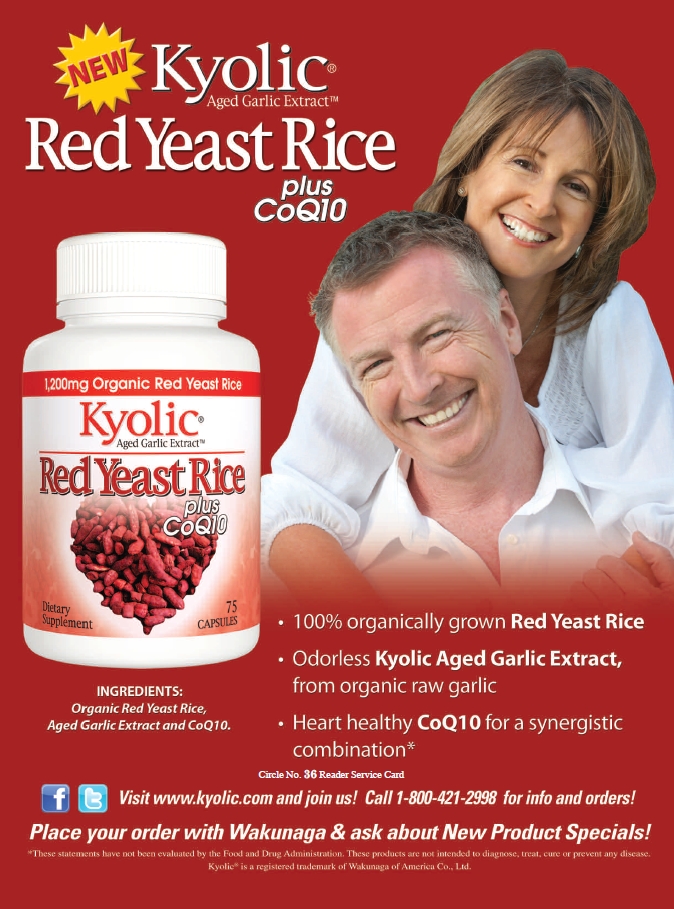 Humans do not manufacture vitamin C internally like other animals, McRae tells us. Without adequate vitamin C, WBC responses can become compromised. Hazels Mitmesser says this is because the vitamin C content in WBCs is relevant to their ability to engulf and destroy invaders. She says that a unique, patented form of vitamin C (Ester-C) stays in WBCs longer.
Humans do not manufacture vitamin C internally like other animals, McRae tells us. Without adequate vitamin C, WBC responses can become compromised. Hazels Mitmesser says this is because the vitamin C content in WBCs is relevant to their ability to engulf and destroy invaders. She says that a unique, patented form of vitamin C (Ester-C) stays in WBCs longer.
There is also evidence that the vitamin might enhance the proliferation of T-lymphocytes, McRae adds, and that vitamin C protects tissues against reactive oxygen species produced by phagocytes during a viral infection. “Vitamin C is a key antioxidant that protects cell and blood components from free radical damage,” echoes Hazels Mitmesser. For these reasons, it is critical for immune responsiveness.
Meletis says he looks at vitamin C beyond the immune spectrum. It is well known that deficiency can lead to scurvy, and issues like gum disease or poor wound healing. When the body is under stress, Meletis says, it uses vitamin C, but because humans don’t synthesize it, we don’t achieve its stress buffering effects as readily.
Though there is no fine line to identify where prevention ends and recovery begins, there are other supplements to single out besides vitamin C that help with acute response. Consumers, meanwhile, are eager to identify quick fixes. Sugarek MacDonald recommends considering each of vitamin C, vitamin D3, zinc and American ginseng for responding quickly to colds and flu.
She says zinc and vitamin C work well in concert, especially in lozenge form, to support antioxidant levels after contracting a cold, as well as for maintaining the airway’s mucosal lining. Recent research investigated the use of 1,000 mg of vitamin C and 10 mg of zinc in lozenge form for the common cold. “In a pooled analysis of both studies, it was reported that vitamin C plus zinc reduced rhinorrhea over 5 days of treatment when compared to placebo,” Sugarek MacDonald says (15).
Up to a 61% reduction in the duration of the common cold or flu was found in a recent study on AGE at the University of Florida (16). “During their study, 120 cold and flu sufferers also experienced a 21% reduction in the number of symptoms and 58% fewer missed work days due to their illness,” Levy says. The researchers attributed this to aged garlic’s boosting of T cells, especially NK cells.
In a double-blind, placebo-controlled human 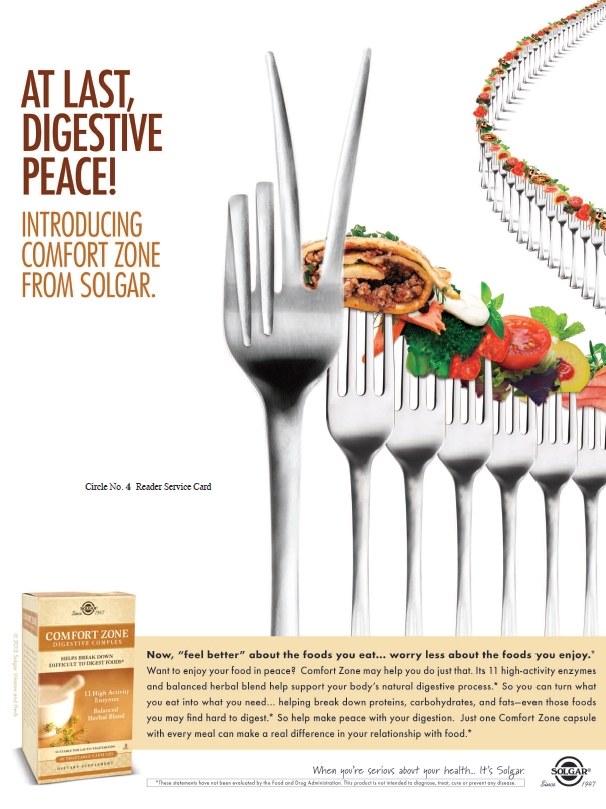 clinical trial, one ingredient already discussed (EpiCor) was shown to significantly increase NK cell activation in as little as two hours. “The job of NK cells, which are a type of WBC that circulate in our blood and tissues, is to quickly and aggressively seek out formerly healthy cells that have been damaged (e.g., a tumor, virus) and then cause that damaged cell to kill itself through a process called ‘programmed cell death,’ which scientists describe as cell apoptosis,” says Larry Robinson, vice president of scientific affairs for Embria Health Sciences, Ankeny, IA.
clinical trial, one ingredient already discussed (EpiCor) was shown to significantly increase NK cell activation in as little as two hours. “The job of NK cells, which are a type of WBC that circulate in our blood and tissues, is to quickly and aggressively seek out formerly healthy cells that have been damaged (e.g., a tumor, virus) and then cause that damaged cell to kill itself through a process called ‘programmed cell death,’ which scientists describe as cell apoptosis,” says Larry Robinson, vice president of scientific affairs for Embria Health Sciences, Ankeny, IA.
Robinson explains, as an aside, that since the typical goal of immune strengthening is to help deal with the stress of everyday living, research should be conducted to match these conditions. Research into suppressed immune systems, like that involving athletes post-competition, should be balanced by research on normal, healthy adults.
Clouatre presents another option for acute response. “There is a tendency to overlook a number of traditional products simply because they are not entirely new, which is a mistake. Some items in the traditional immune arsenal continue to be the objects of successful human tests,” he says, citing lactoferrin as an example. He says its track record of supporting immune health in the face of challenges is supported by a recent study, showing that a combination of lactoferrin with whey protein could decrease incidence of colds (17).
Explaining this impact, Clouatre says that at least half of the phagocyte immune cells in the body are found in the gastrointestinal tract, the place where potential invading pathogens are encountered and where “active skirmishes between pathogens and our immune system” occur. Lactoferrin reduces the pathogenic burden, freeing immune resources to fight back, and whey protein protects the body with precursors to antioxidants, together forming an effective combination.
Mushroom-based AHCC can be of benefit after individuals experience flu symptoms, Lifton says. How? It works by increasing the number and activity of NK cells, macrophages, dendritic cells and T cells. He says it has also been clinically shown to beneficially increase cytokine activity.
 “Research on herbs such as andrographis, oregano oil and berberine sulfate continues to support their benefits in helping to ease sinus and respiratory discomfort. These herbs also mobilize the body’s acute response,” Hobbs adds.
“Research on herbs such as andrographis, oregano oil and berberine sulfate continues to support their benefits in helping to ease sinus and respiratory discomfort. These herbs also mobilize the body’s acute response,” Hobbs adds.
For bacterial infections, antimicrobial support in the upper respiratory area can be of help, Sugarek MacDonald says, and she describes the use of olive leaf and oil of oregano for this purpose. As antibiotic drugs have some problems associated with their use, she feels it is advantageous to consider natural antimicrobial agents like these, to which bacteria cannot develop their own immunity.
Olive leaf extract, in addition to acting as an antioxidant, exhibits antimicrobial action against pathogens such as Salmonella typhi, Vibrio parahaemolyticus, Staphylococcus aureus (including penicillin-resistant strains), Klebsiella pneumoniae and E. coli, each agents of intestinal or respiratory tract infections in humans, according to Sugarek MacDonald. The compound usually credited for olive leaf’s antimicrobial properties is oleuropein.
“Oil of oregano may not inhibit the influenza virus, but it sure does help your lungs recover from a bout with a cold or flu by thinning the mucus in the upper respiratory tract, therefore allowing for easier breathing and faster removal of the infecting virus,” Sugarek MacDonald says, emphasizing that only oregano oil produced from wild Mediterranean species has been proven to demonstrate these properties.
There is, of course, the need to soothe sore throats when such illnesses present themselves. A natural cough syrup comprised of five herbal extracts, six essential oils and wildflower honey is one answer, according to Karen Page, national sales manager for Penn Herb Company Ltd., Philadelphia, PA, U.S. importer of Olbas Herbal Remedies.
Developed in Europe over 100 years ago, the formula provides natural antioxidant support, strengthens lung function and supports mucosal membranes in the respiratory tract, helping to clear bronchial passages. “A study conducted at the Pennsylvania School of Medicine came up with honey as a safe alternative to effectively treat coughs and soothe sore throats,” Page says.
|
Immune Support Products
American Health: Ester-C, 500 mg and 1000 mg, capsule, vegetarian capsule, vegetarian tablet, powder, effervescent, liquid, chewables; Ester-C 1000 mg with Probiotics (6 billion) Digestion & Immune Health Complex; Ester-C 1000 mg with D3 (5000 IU) Bone & Immune Health Complex; Ester-C 1000 mg Advanced Antioxidant Formula, Ester-C 1000 mg with Cranberry (2000 mg) Cranberry & Immune Health Complex; Probiotics: chewable, liquid, Enzyme Probiotic Complex, Probiotic CD (Controlled Delivery), Capsules with Citrus Pectin; Acerola Plus Chewables. |
|
The need for immunity doesn’t cease once illness is gone, as the next immune challenge could be right around the corner. “The combination of shiitake and royal agaricus I have found to be an excellent re-builder, useful in recovery from various depleting conditions, both acute and chronic, and including colds and flus as well as chronic fatigue related conditions,” says Kaylor. However, he adds, cordyceps is likely the most effective mushroom for recovery in general.
Immune Support Market
As its mainstream popularity grows, the immune support space will morph and change, as suppliers and manufacturers gauge consumer preferences and adjust their products to match. Retailers have the opportunity to leverage consumer demand in this market even as its trends continue to shift.
“If you look at the shelves of the health food immune aisles, you find that there is largely a bifurcation between ‘kitchen sink’ long-term products designed for general health and products intended specifically to treat colds and flu over the short term,” says Clouatre. Outside of a heavy mushroom presence, this first “long term” category lacks focus, he believes. The cold and flu side of things is currently centered on echinacea, elderberry and related items, as well as zinc lozenges in some cases. Outside of allergy concerns, the digestive system is not often viewed as a primary site of immune action, judging by store shelves, Clouatre says. Also judging by shelves, most customers seem to want “quick fixes” aimed at symptom alleviation.
The pre-, pro- and synbiotics market for immunity is coming, he argues. The research in this area continues to pour in. “Consumers just need to be brought up to speed on the emerging science,” Clouatre says, adding that consumers seem to have already given the nod to multi-strain probiotics. Rodriguez thinks many consumers are already making the digestive/immune health link, and that combination pre-/probiotic products have influenced this trend. Gateway products are also a factor. “The success of yogurts over the years has affected the association of immune health and gut health with consumers, which has opened up the category to be more than just a seasonal story,” says Doug Reyes, sales and marketing manager for Embria Health Sciences.
There is also some crossover taking place, Clouatre says, such as .probiotics potentially being marketed in areas like mood elevation. Another example is the increasingly recognized role of inflammation in obesity and blood sugar management opening the door for immune products in these areas.
American consumers are more aware of the need to support immunity in general today, claims Donna Noonan, president of Mushroom Wisdom Inc. “They know that when and if their immune systems are impacted or functioning less than optimally, they set the stage for adverse health conditions to set in,” she says, adding, “Stress is a top factor impacting healthy immunity, and this leads to opportunities for retailers to ‘package’ stress and immune supplements together in the supplement aisles.”
Levy claims, however, that only a small percentage of the population is actively attempting to manage an already compromised immune system. This indicates that products designed to help with prevention will still reach the largest share of consumers, and he says this trend is stable. The uncertain economy is one reason, as fear of financial trouble combined with health care worries has people taking safeguards.
There are also negatives associated with mainstream over-the-counter products that are influencing consumers toward natural alternatives. “Recently many children’s cough syrups have been taken off the market because of concerns over some of the potentially harmful ingredients in those formulas,” says Page.
The areas of formulation and product marketing are as intriguing as the sales trends. Mueller says that as we see immune products emerge in every form, from foods to beverages to supplements, a priority is being placed by manufacturers on the strength of the science. The main reason is it dictates the types of health claims that can be made. “Companies want compelling and innovative claims that will pass the scrutiny of regulators,” Mueller says, and savvy marketers are aware that claims must be impactful enough to ensure consumer interest.
Another priority, as the supplements market becomes more sophisticated, is on producing consistently efficacious products. See says, “When developing a new product for immune support, supplement makers must consider both bioavailability and bio-efficacy—to ensure absorption of the bioactives and that they are delivered to the various organs and confer the benefits that they claim to have.” This is where issues like finding the right delivery format come into play.
“Just like other product categories, there is a growing trend toward delivery formats that expand beyond capsules and hard tablets. Chewable tablets, gums, gummies and teas provide alternatives, especially for individuals who have difficulty swallowing large capsules or tablets,” says Dockery.
One potential trend to note is powdered supplements. Meletis points to the small percentage of Americans that get the recommended servings of fruits and vegetables, while also acknowledging that quality produce gets expensive. He says for this reason many people are looking to powdered green and red vegetable supplements. “Most of them will mix one to two packs of veggies into 16 ounces of water a couple of times a day. Besides the normal benefits of getting more fruits and veggies, it also helps with hydration,” Meletis says. Mucous membranes have been shown to be less resilient when dehydrated.
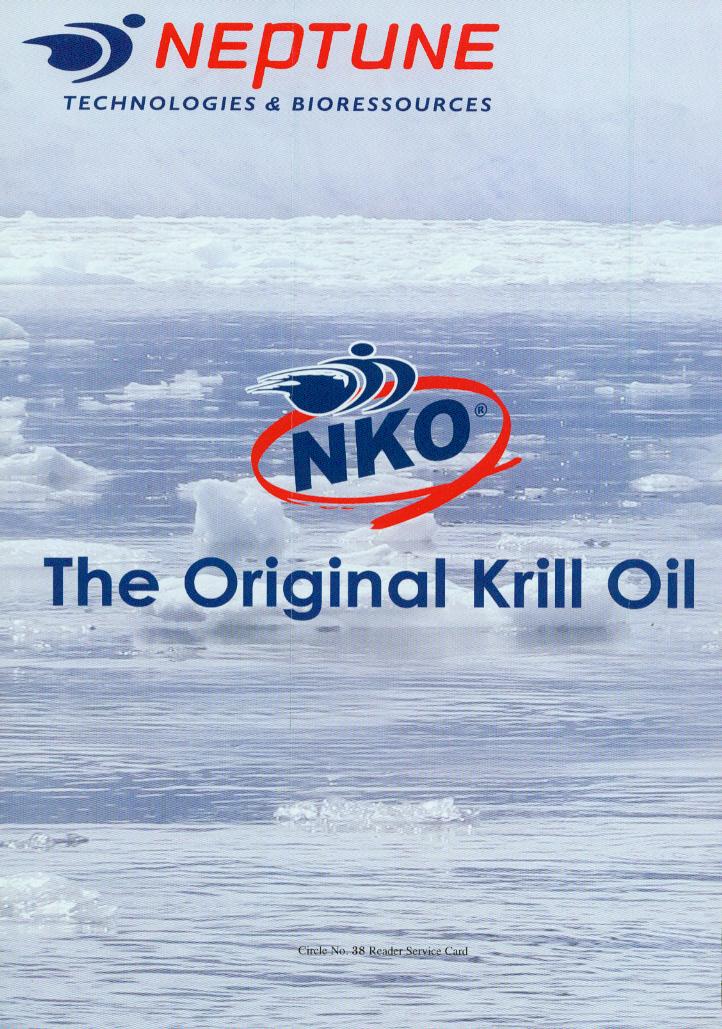 “We have seen trends in stick packs with water-soluble powder being developed for easy portability as an alternative for popping pills,” says Lifton. Smaller soft gels are also being introduced, in part made possible by greater concentration of ingredients.
“We have seen trends in stick packs with water-soluble powder being developed for easy portability as an alternative for popping pills,” says Lifton. Smaller soft gels are also being introduced, in part made possible by greater concentration of ingredients.
Tried and true is holding strong, however. “Although many companies are exploring different delivery formats such as drink mixes, functional foods, or immune-boosting energy shots, traditional dietary supplements in capsule or tablet form remain the first choice among consumers to strengthen the immune system, according to Gallup,” says Levy.
Though people are aware of the need to supplement regularly if they hope to effectively boost immunity, convenience or lack thereof is still an obstacle for some. “A once-a-day, one to two pill or capsule routine is easily managed by most busy consumers. Immune boosters that require preparation or multiple doses throughout the day are less attractive,” says Levy.
These product trends can be put in front of your customers through in-store educational seminars, says Lifton. While consumers are aware of the category, their knowledge is mostly superficial, so retailers can use seminars, in-store displays and other marketing materials to explain specific ingredients and how they work. Staff training is also important, he says.
Noonan suggests initiating partnerships with local stress management counselors, yoga studios and dietitians who can speak to the need for a healthy diet that helps limit stress, as stress-induced biochemicals like cortisol can often impact immune status. WF
References
1. L.R. Fitzpatrick, “Probiotics for the Treatment of Clostridium Difficile Associated Disease,” World J. Gastrointest. Pathophysiol. 15;4(3), 47-52 (2013).
2. D.A. Vattem, et al., “Dietary Supplementation with Two Lamiaceae Herbs (Oregano and Sage) Modulates Innate Immunity Parameters in Lumbricus Terrestris,” Pharmacognosy Res. 5(1), 1-9 (2013).
3. S. Vimalanathan, et al., “Optimisation of Echinacea Purpurea Extraction and Processing to Yield High Potency Antiviral Activity,” Planta. Med. 79(13) PK41 (2013).
4. A. Chicca, et al., “Synergistic immunomopharmacological effects of N-alkylamides in Echinacea purpurea herbal extracts,” Int. Immunopharmacol. 9(7-8), 850-8 (2009).
5. Z. Ren, et al., “Dietary Supplementation with Tocotrienols Enhances Immune Function in C57BL/6 Mice,” J Nutr. 140(7), 1335-41 (2010).
6. D. Mahalingam, et al., “Effects of Supplementation with Tocotrienol-rich Fraction on Immune Response to Tetanus Toxoid Immunization in Normal Healthy Volunteers,” Eur J Clin Nutr. 65(1), 63-9 (2011).
7. E. Kinoshita, et al., “Anti-influenza Virus Effects of Elderberry Juice and its Fractions,” Biosci. Biotechnol. Biochem. 76(9), 1633-8 (2012).
8. B.E. Roman, et al., “Short-term Supplementation with Active Hexose Correlated Compound Improves the Antibody Response to Influenza B Vaccine,” Nutr. Res. 33(1), 12-7 (2013).
9. A. Chuthaputti, et al., “The Efficacy of Andrographis paniculata (Burm. f.) Wall. ex Nees for the Relief of the Symptoms of Influenza,” J. Thai Trad. Alt. Med. 5(3) (2007).
10. C. Hughes, et al., “Galactooligosaccharide Supplementation Reduces Stress-induced Gastrointestinal Dysfunction and Days of Cold or Flu: A Randomized, Double-blind, Controlled Trial in Healthy University Students,” Am. J. Clin. Nutr. 93(6), 1305-11 (2011).
11. S. Possemiers, et al., “A Dried Yeast Fermentate Selectively Modulates both the Luminal and Mucosal Gut Microbiota and Protects against Inflammation, As Studied in an Integrated in Vitro Approach,” J. Agric. Food. Chem. Epub ahead of print, Sept. 19 (2013).
12. F. Di Pierro, et al., “Preliminary Pediatric Clinical Evaluation of the Oral Probiotic Streptococcus Salivarius K12 in Preventing Recurrent Pharyngitis and/or Tonsillitis Caused by Streptococcus Pyogenes and Recurrent Acute Otitis Media,” Int J Gen Med. 5, 991-7 (2012).
13. F. Di Pierro, et al., “Clinical Evaluation of the Oral Probiotic Streptococcus Salivarius K12 in the Prevention of Recurrent Pharyngitis and/or Tonsillitis caused by Streptococcus Pyogenes in Adults,” Exp. Opin. . Biol. Ther. 13 (3), 339-43 (2013).
14. J.K. Udani, et al., “Proprietary arabinogalactan extract increases antibody response to the pneumonia vaccine: a randomized, double-blind, placebo-controlled, pilot study in healthy volunteers,” Nutr. J. 9, 32 (2010).
15. S. Maggini, S. Beveridge, M. Suter, “A Combination of High-dose Vitamin C Plus Zinc for the Common Cold,” J. Int. Med. Res. 40(1), 28-42 (2012).
16. M.P. Nantz, et al., “Supplementation with Aged Garlic Extract Improves both NK and Gamma Delta T cell Function and Reduces the Severity of Cold and Flu Symptoms: a Randomized, Double-blind, Placebo-controlled Nutrition Intervention,” Clin Nutr. 31(3), 337-344 (2012).
17. L. Vitetta, et al., “The Clinical Efficacy of a Bovine Lactoferrin/Whey Protein Ig-rich Fraction (Lf/IgF) for the Common Cold: A Double Blind Randomized Study,” Complement. Ther. Med. 21(3), 164-71 (2013).
Published in WholeFoods Magazine, November 2013

